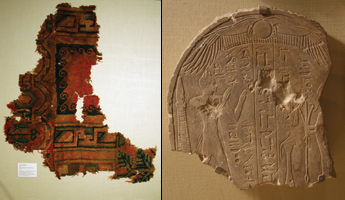|
||
      |
Original Source
Polyglot empire
 When
Nubians conquered Egypt in 760 BC—after centuries of Egyptian dominance
and colonization—“they put in deep roots,” says Oriental
Institute archaeologist Stephen P. Harvey. Nubians absorbed Egyptian religious
traditions (often reviving lapsed rites) and appointed conquerors’ daughters
high priestesses of the god Amun. Some swapped conventional round tombs
for Egyptian pyramids. “And,” says Harvey, pointing to a funereal
limestone stele, or carved slab (top right), in the Oriental Institute’s
Robert F. Picken Family Nubia Gallery, “they realized the importance
of burying their queens and princesses in Egyptian sacred sites.” Depicting
Nubian crown prince Pekartror praying to the underworld god Osiris, the
stele was discovered in Abydos—home to Egypt’s earliest royal
pyramids—in the tomb where Pekartror buried his mother, Pabatma. “It’s
very savvy,” says Harvey, who since 1993 has excavated the ruins
of Egyptian pharaoh Ahmose’s Abydos pyramid. “They asserted
power in a xenophobic Egypt by adapting Egyptian tradition to their own
uses.” Nubia ruled Egypt for nearly 100 years.
When
Nubians conquered Egypt in 760 BC—after centuries of Egyptian dominance
and colonization—“they put in deep roots,” says Oriental
Institute archaeologist Stephen P. Harvey. Nubians absorbed Egyptian religious
traditions (often reviving lapsed rites) and appointed conquerors’ daughters
high priestesses of the god Amun. Some swapped conventional round tombs
for Egyptian pyramids. “And,” says Harvey, pointing to a funereal
limestone stele, or carved slab (top right), in the Oriental Institute’s
Robert F. Picken Family Nubia Gallery, “they realized the importance
of burying their queens and princesses in Egyptian sacred sites.” Depicting
Nubian crown prince Pekartror praying to the underworld god Osiris, the
stele was discovered in Abydos—home to Egypt’s earliest royal
pyramids—in the tomb where Pekartror buried his mother, Pabatma. “It’s
very savvy,” says Harvey, who since 1993 has excavated the ruins
of Egyptian pharaoh Ahmose’s Abydos pyramid. “They asserted
power in a xenophobic Egypt by adapting Egyptian tradition to their own
uses.” Nubia ruled Egypt for nearly 100 years.
Cultural assimilation was common in ancient Nubia, today’s northern Sudan and southern Egypt. Nubians borrowed and reworked Egyptian hieroglyphics, names, and symbols. “They maintained their strong ethnicity, though,” Harvey says. “They didn’t want to take over those traditions wholesale.” Nubians’ facial features, complexions, and dress differed from Egyptians’, a fact they emphasized in sculptures and portraits. And many of the museum’s artifacts reflect Nubia’s archery and equestrian prowess. Noting the mixture of shared and unique traditions, Harvey says Nubia occupies “a different cultural stream, but it’s one Nile.”
No artifact in the collection makes this point more plainly than a three-foot-square scrap of carpet (top left) found in a Nubian warrior’s tomb. Dating from 400 AD, it incorporates Byzantine patterns—architectural arcades, running spirals, and geometric designs. The carpet itself came from western Asia. “This is an amazing thing,” Harvey says. “It demonstrates Nubia’s participation in the wider world.”